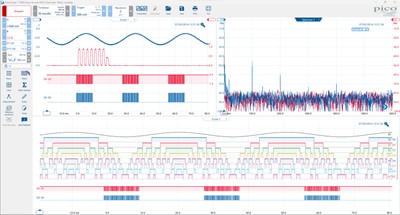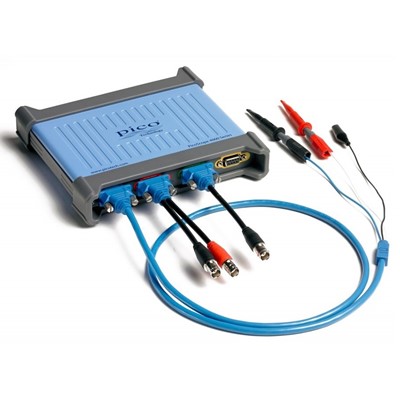Request Demo Device
This allows you to test and evaluate the product under real conditions before making a purchase decision
The following conditions apply:
1. Return Obligation
At the end of the test period (2 weeks), the demo device must be returned unsolicited and at the customer's expense in perfect condition, including accessories and packaging, as an insured package.
2. Liability for Damage / Loss
During the test phase, the customer is liable for loss of or damage to the device and the accessories supplied. 3. No Transfer to Third Parties
The demo unit may not be transferred or rented to third parties.
4. For Testing Only – No Permanent Loan
The unit is provided strictly for testing and evaluation purposes. Use in continuous operation, productive environments, or resale is not permitted.
5. Subject to Availability
Demo units are provided free of obligation and subject to availability. There is no legal claim to receiving a demo unit. Demo units are only available to customers located within the European Union.
6. One-Time Demo per Product/Customer
As a rule, only one demo unit per product and customer is provided.
Best Price Guarantee
Send us the supplier's written offer or the website where the product is offered at a lower price to benefit from this guarantee.
The best price guarantee does not apply to offers from remaining stock or excess stock or to offers from countries outside the EU.
With four true differential inputs, 12- to 14-bit resolution and wide differential and common-mode voltage ranges, the PicoScope 4444 and its accessories offer accurate and detailed measurement for a multitude of applications. The 9-pin D-type connectors provide a true differential probe interface, and also allow the PicoScope software to automatically identify the probe and select the appropriate display settings.
Key performance data:
- 4 analog channels, differential high-impedance inputs
- up to 20 MHz analog bandwidth
- Flexible 12 and 14-bit ADC resolution
- up to 400 MSa/s maximum sampling rate (shared between active channels)
- up to 256 MSa memory depth (shared between active channels)
- Dedicated probe interface
- USB 3.0 connected and powered
Features

Advanced Display
One of the biggest differences between using a PicoScope and a benchtop scope is the display.
The PicoScope 6 software can display up to 16 scope and spectrum views at once, making comparisons and analysis even clearer. The split-screen display can be customized to show whichever combination of waveforms you need, to display multiple channels or different variants of the same signal. Additionally, each waveform shown works with individual zoom, pan, and filter settings for ultimate flexibility.
The PicoScope software can be controlled by mouse, touchscreen or keyboard shortcuts.
Differential measurements in high resolution
The PicoScope 4444’s four Pico D9 inputs allow you to make true differential measurements. The maximum input range at full scale is ±50 V (±1000 V using the PicoConnect 442 1000 V CAT III probe), and the maximum common-mode range is also ±50 V (also ±1000 V with the PicoConnect 442 probe). You can set the scope to measure at resolutions of 12 or 14 bits, far better than the 8-bit resolution typical of many oscilloscopes. The deep capture memory (up to 256 million samples shared by the active channels) is another advantage, allowing you to carry out long captures without lowering the sampling rate. The two images on the right show a sine wave with a sawtooth interference pattern, displayed on an 8-bit PicoScope 2208B (left) and a PicoScope 4444 in 12-bit mode (right). The PicoScope 2208B has greater bandwidth and a faster sampling rate than the PicoScope 4444, but fails to resolve the fine detail of the signal. The 12-bit resolution of the PicoScope 4444 offers 16 times as much vertical detail, and its deeper capture memory of 256 MSa gives it greater horizontal resolution, too.
Why use the PicoScope 4444?
There are, of course, plenty of differential probes available, all with similar inconveniences: bulky interface boxes, missing or flat batteries, snaking power leads... The PicoScope 4444 uses specially designed passive voltage probes that have smaller and lighter (or no) interface boxes. The PicoScope 4444 has high resolution and deep memory and lets you make multiple differential measurements at the same time, while never occupying more than one power socket. Its intelligent probe interface automatically configures the PicoScope display to your probes, so you don’t have to.
Pre-configured kits
Apart from the base unit and accessories there are three preconfigured kits with everything you need to get started with differential measurement. Each kit includes a PicoScope 4444 high-resolution differential oscilloscope and three differential voltage probes with Pico D9 connectors. The kits also come with a TA271 D9‑BNC adaptor, which lets you use traditional oscilloscope voltage probes and current probes, to make single-ended measurements with a ground-referenced probe. Finally, all three kits are delivered in a sturdy carry case.
Intelligent probe interface
When you connect any Pico Technology probe with D9 connection to the PicoScope 4444, the PicoScope 6 software will detect, identify and, where necessary, power it. This means you spend less time setting up and don’t have to worry about battery packs or power supplies. The software automatically sets up the display and controls to match your probe. A notification appears in the bottom right corner of the PicoScope display whenever you connect or remove a probe.
Digital triggering
The majority of digital oscilloscopes still use an analog trigger architecture based on comparators. This causes time and amplitude errors that cannot always be calibrated out and often limits the trigger sensitivity at high bandwidths.
In 1991 Pico pioneered the use of fully digital triggering using the actual digitized data. This technique reduces trigger errors and allows our oscilloscopes to trigger on the smallest signals, even at the full bandwidth. Trigger levels and hysteresis can be set with high precision and resolution.
The reduced rearm delay provided by digital triggering, together with segmented memory, allows the capture of events that happen in rapid sequence. On many of our products, rapid triggering can capture a new waveform every microsecond until the buffer is full.
Advanced triggers As well as the standard range of triggers found on most oscilloscopes, the PicoScope 4000A Series has a comprehensive set of advanced triggers built in to help you capture the data you need. These include pulse width, windowed, and dropout triggers to help you find and capture your signal quickly
Portable & personal
PicoScope 4000 Series USB-powered PC oscilloscopes are small, light, and portable and can easily slip into a laptop bag while offering a range of high-performance specifications.
On the bench a PicoScope saves valuable space and allows the scope to be placed right by the unit under test.
Laptop users benefit even more: with no power supply required you can now carry an oscilloscope with you all the time in your laptop bag. Perfect for the engineer on the move.
Many engineers buy a PicoScope with their own money. That way wherever they work in their careers they have their own personal oscilloscope without having to share or waste time learning different user interfaces.
Download new features or write your own
The software development kit (SDK) allows you to write your own software and includes drivers for Microsoft Windows, Apple Mac (OS X) and Linux (including Raspberry Pi and BeagleBone).
Example code shows how to interface to third-party software packages such as Microsoft Excel, National Instruments LabVIEW and MathWorks MATLAB.
There is also an active community of PicoScope users who share code and applications on the Pico forum and PicoApps section of the picotech.com web site.
Example code, hosted on the Pico Technology GitHub pages, shows how to interface to third-party software packages such as Microsoft Excel, National Instruments LabVIEW and MathWorks MATLAB and programming languages including:
- C
- C++
- C#
- Visual Basic .NET The drivers support USB data streaming, a mode that captures gap-free continuous data over USB direct to the PC’s RAM or hard disk at rates of up to 156.25 MS/s for USB 3.0 devices. Capture size is limited only by available PC storage. Sampling rates in streaming mode are subject to PC specifications, product specifications and application loading.
Common
Price
Article Group
Manufacturer
Probe
Type
Features
Best Price Guarantee
Send us the supplier's written offer or the website where the product is offered at a lower price to benefit from this guarantee.
The best price guarantee does not apply to offers from remaining stock or excess stock or to offers from countries outside the EU.
Request Demo Device
This allows you to test and evaluate the product under real conditions before making a purchase decision
1. Return Obligation
At the end of the test period (2 weeks), the demo device must be returned unsolicited and at the customer's expense in perfect condition, including accessories and packaging, as an insured package.
2. Liability for Damage / Loss
During the test phase, the customer is liable for loss of or damage to the device and the accessories supplied. 3. No Transfer to Third Parties
The demo unit may not be transferred or rented to third parties.
4. For Testing Only – No Permanent Loan
The unit is provided strictly for testing and evaluation purposes. Use in continuous operation, productive environments, or resale is not permitted.
5. Subject to Availability
Demo units are provided free of obligation and subject to availability. There is no legal claim to receiving a demo unit. Demo units are only available to customers located within the European Union.
6. One-Time Demo per Product/Customer
As a rule, only one demo unit per product and customer is provided.
Downloads
Datasheet
Ficha Técnica PicoScope 4444
Language: Spain
Version: MM082.es-5
File Size: 13.86 MiB
Release Date: 19.07.2021
Fiche Technique du PicoScope 4444
Language: French
Version: MM082.fr-5
File Size: 14.28 MiB
Release Date: 19.07.2021
PicoScope 4444, data sheet
Language: German
Version: MM082.de-5
File Size: 14.22 MiB
Release Date: 23.05.2021
functions and specifications
PicoScope 4444, data sheet
Language: English
Version: MM082.en-6
File Size: 5.78 MiB
Release Date: 23.05.2021
functions and specifications
Scheda tecnica PicoScope 4444
Language: Italian
Version: MM082.it-5
File Size: 5.80 MiB
Release Date: 19.07.2021
Manual
PicoConnect 442, users guide
Language: German, English, Chinese, Spain
Version: DO283-2
File Size: 1.40 MiB
Release Date: 23.05.2017
This manual describes the PicoConnect 442 probe for the PicoScope-4444 differential oscilloscope.
PicoScope 4444, quick start guide
Language: German, English, Chinese, Spain, French, Italian
Version: DO282-4
File Size: 3.73 MiB
Release Date: 11.01.2022
This guide explains how to install the PicoScope software and connect the oscilloscope to your computer. It also contains important safety information and advice on accessing user manuals and technical support.
PicoScope USB oscilloscopes, quick start guide
Language: German, English, Chinese, Spain, French, Italian
File Size: 4.87 MiB
Release Date: 24.08.2022
Software
PicoScope 7 Software users guide
Language: English
Version: psw7.en-1
File Size: 59.37 MiB
Release Date: 07.05.2025
PicoScope 7 is the oscilloscope software that is available for all PicoScope® oscilloscopes. There are versions for Windows, macOS and Linux. All the advertised features are included in the purchase price of your oscilloscope, so there are no expensive add-on software modules to buy later.
Guide
PicoScope 4000A series, A API programmers guide
Language: English
Version: ps4000apg.en-9
File Size: 2.78 MiB
Release Date: 11.01.2022
This Programmer's Guide explains how to use the ps4000a API, the Application Programming Interface for the PicoScope 4000 Series (A API) and PicoScope 4000A Series oscilloscopes. The ps4000a API supports the following models: · PicoScope 4444 4-channels · PicoScope 4824 8-channels · PicoScope 4224A 2-channels · PicoScope 4424A 4-channels · PicoScope 4824A 8-channels






